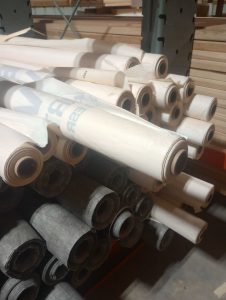Does My Pole Barn Need a Vapor Barrier Above the Metal Ceiling?
Reader DAVID in BALDWINSVILLE writes:
“I have a new pole barn with bubble vapor barrier under roof metal. I am installing a metal ceiling with R-38 cellulose in the attic. Do I need a vapor barrier above the metal ceiling? The barn will be heated somewhat in winter.”
From Mike the Pole Barn Guru:
Kudos to you for recognizing bubble wrap products advertised as ‘insulation’ are, at best, a good vapor barrier if properly sealed!
My son Brent is working on his doctorate at UMass Amherst, so I utilized Building and Construction Technology information from their Department of Environmental Conservation in penning this response.
My concern is with blowing in cellulose above a steel ceiling. From UMass:
 “Wet insulation of any stripe is bad. But cellulose is hygroscopic. It’s able to soak and hold liquid water. Undetected leaks can wet cellulose causing it to sag within framing cavities. Water leaks can compress the blanket of fiber and in extreme cases, can create a void space, degrading its thermal value. Another concern is that chemicals used to protect cellulose from fire make it potentially corrosive in wet environments. Tests conducted by the Oak Ridge National Laboratory show chemical treatments used to treat cellulose can cause metal fasteners, plumbing pipes and electrical wires to corrode if left in contact with wet, treated cellulose insulation for extended periods of time. “
“Wet insulation of any stripe is bad. But cellulose is hygroscopic. It’s able to soak and hold liquid water. Undetected leaks can wet cellulose causing it to sag within framing cavities. Water leaks can compress the blanket of fiber and in extreme cases, can create a void space, degrading its thermal value. Another concern is that chemicals used to protect cellulose from fire make it potentially corrosive in wet environments. Tests conducted by the Oak Ridge National Laboratory show chemical treatments used to treat cellulose can cause metal fasteners, plumbing pipes and electrical wires to corrode if left in contact with wet, treated cellulose insulation for extended periods of time. “
I’d much prefer to see you blowing in rockwool as it remains unaffected by moisture. Last thing you want is to have damp cellulose insulation chemicals eating holes in your ceiling.
According to building scientist and founding principal of Building Science Corporation Joe Lstiburek, “Plastic vapor barriers should only be installed in vented attics in climates with more than 8,000 heating degree days.”
As your site has under 8000 heating degree days a year, you should not have a ceiling vapor barrier. You do need to ensure your newly created non-conditioned dead attic space is adequately ventilated at eave and ridge (https://www.hansenpolebuildings.com/2018/03/adequate-eave-ridge-ventilation/).
For extended reading on heating degree days, please see: https://www.hansenpolebuildings.com/2022/11/what-is-degree-day/






